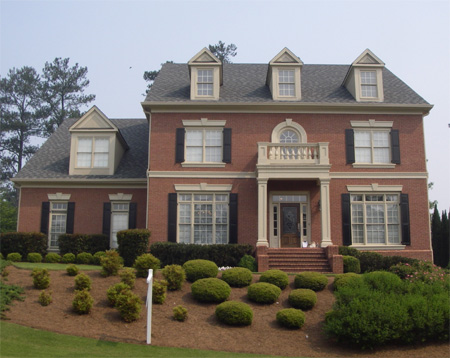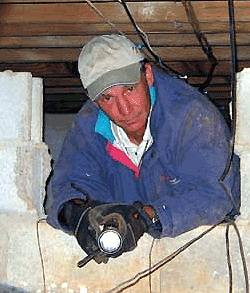|
Dan's Blog
The Top Ten Things This Home Inspector Shouldn’t Tell You
Tuesday, June 19, 2007
Professional standards and common sense dictate that home inspectors (and real estate agents, appraisers, lenders, builders, etc. etc.) should not share their opinions with the homebuyer. That doesn't mean we don't have opinions. Here are a few I've gathered over 20 years as a home inspector in the Atlanta metro area
- You are getting pretty much what you want. Inspections usually turn out OK: results most often are neither as good as we wish nor as bad as we fear. Beware the inspector who characterizes the home as perfect or (more often) a money pit. Sometimes homes really ARE in bad shape and when that happens inspectors should tell you so. Homes are a reflection of our cultural expectations: you wouldn't have written a contract for the place if it didn't appeal to you in some way.
- Design is secondary. For a variety of reasons the architects’ role in homebuilding has evolved to a position subservient to the builder. Need a plan?-buy a book of home designs. Buyers want big homes with lots of features, not some intellectual vision of “house”. There are few exceptions; Sarah Susanka comes to mind, but most of us don't have much use for or the financial means to employ a residential architect. This lowering of the level of architectural input into the homebuilding process has significant implications: livability and aesthetics suffer, durability is reduced and you can't build your way out of design flaws.
- Your house is too big and full of ornamentation. Yes, it’s nice to have a closet the size of a bedroom, a three car garage, 6x9 foot windows, a full finished basement, an outdoor fireplace, a jetted tub, a security system, sprinklers, two ovens, a bathroom for each bedroom, a media room, study, keeping room, formal living and dining, master-on-main, vaulted great room, multiple fireplaces, guest house, cabana and pool, workshop, office, Sub-Zero frig, commercial range, seven gabled roof with hipped ridges and shed metal porch, stone, shingle, brick, vinyl, and lap sidings in addition to the ubiquitous granite countertop but where does this all end? It sure makes my job more difficult inspecting all this stuff.
- You have little usable outdoor space. Many people do not spend time outside while at home. We are comfortable having a reasonable front façade, a serviceable backyard and that’s about it. Gardeners are the rare exception. Larger homes built closer to each other on less desirable lots (level and gently-sloped sites are no longer readily available) mean less space available for outdoor activities.
- Your new home has started failing before the ink on the settlement statement has dried. We are born only to face our own demise and houses are no different. Aside from the foundation most of a home is built of wood and wood decays: it’s both the builders’ and the homeowners’ job to slow that process. Part of the problem is quality control/workmanship (see my article Inspectors Lament) and part is quality assurance (design issues). It’s often a better financial option to move to a newer home to avoid the expense of maintaining an older one. Older homes that are architecturally distinctive and/or are located in desirable neighborhoods present their own financial and maintenance obstacles.
- Moisture problems are guaranteed. Drainage, grading, and waterproofing are “unseen” features: they do NOT sell houses. The bigger the house the more runoff it generates. It’s not a question of if there will be moisture issues but when. Ask ANY inspector what is the most common problem they encounter.
- Utility costs will be higher than necessary. Like a Hummer with an efficient engine costs will be higher in part because there is more space to heat and cool just as there is more mass and volume to overcome when driving a larger vehicle, despite its’ more efficient engine. Home “engines” include more efficient heating and air conditioning equipment and better sealing of the conditioned space. But the size of the home; the distances air and water must travel and the configuration and volume of space to be conditioned increase the amount of energy required for comfort. Homeowners seem to be willing to pay for the increased costs associated with size; higher prices at the pump AND utility meters.
- Many of the people building your home are beginners and low bidders. We all have to start somewhere-why not YOUR home? Builders have to keep costs down to remain competitive so they often take the low bid. (read Inspectors Lament) If project management is good the subcontractors will be required to provide quality work. This begs the question: Where do you expect to find subs who are satisfied with the equivalent of 1974 wages? If you guessed beginners and immigrants you just might be right.
- Maintenance costs will be higher. If those gutters on your large house are 30 ft. from the ground it will cost more to clean them. What I call Unsheltered Design; exterior walls not protected from the elements, contributes to a host of problems. Lack of adequate shelter often contributes to rotted wood, failed thermopane window seals, moisture paths into the wall framing, higher heating and cooling loads and basement moisture.
- You are getting pretty much what you want. Yes, I know it’s a repetition but this part is important. If I might coin a phrase to describe current residential building in Atlanta I choose “Nouveau Victorian”. 100 years ago Victorian homes (Grant Park and West End in Atlanta) reflected an age of wealth and opulence. Why not “Live Large” and enjoy what you have worked hard to get? That’s fine by me. Just don't expect your home to be particularly efficient, comfortable, and easy to maintain. There are lots of ways to improve home performance, increase comfort and durability and save water and energy. If and when you are interested drop me a line.

Almost every doublepane window seal at
the front of this 8 year old home has failed.
Thermal expansion of the glass is the likely cause
for the premature failure of the window seals.
The windows face West and are not sheltered.
Dan Curl
|
|
|
|



